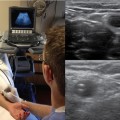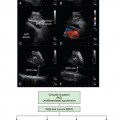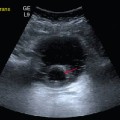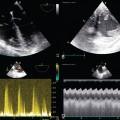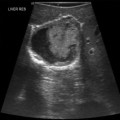5 As mentioned in preceding chapters, transcranial Doppler (TCD) ultrasonography is a noninvasive technique that uses low-frequency transducers for real-time evaluation of cerebral arteries in adults and in children with a closed anterior fontanelle.1–3 TCD has been increasingly used for cerebral circulation monitoring in the pediatric intensive care unit (PICU), and it has become an essential tool for managing sickle cell disease in children.2,3 Two types of TCD devices are available: blind TCD and transcranial color Doppler imaging (TCDI) ultrasonography, which links pulsed-wave Doppler to color mapping for a more accurate identification of arteries. In this chapter, we present TCDI applications in the PICU. TCDI transducers are sector or phased-array low-frequency (1.8-4.0 MHz) dedicated probes with small footprints that facilitate insonation of the intracranial arteries via the temporal window. The transducer is placed just anterior to the ear’s tragus and above the zygoma, and the axial grayscale view of the base of the brain depicts the hypoechoic “butterfly-shaped” cerebral peduncles and the echogenic “star-shaped” suprasellar cistern (reference landmarks).3 The circle of Willis, which is depicted on color mode, projects anteriorly (Figure 5-1). The middle cerebral artery (MCA) is coded red, with blood flow circulating toward the transducer. Color-scale settings should be optimized according to the blood velocities. After switching to the spectral Doppler mode, the 4- to 5-mm–wide Doppler sample gate is placed on the initial part of the MCA, and the recording is optimized by slightly tilting and sliding the transducer to obtain the cleanest and highest-velocity spectrum, which indicates that the axis of the vessel and the Doppler beam are closely aligned. Two to three spectra are recorded, and the most powerful signal at the highest mean blood velocity is used for measurement. The temporal window also allows for recording the internal carotid artery and the anterior and posterior cerebral arteries. However, because the MCA is the main cerebral artery that supplies blood to 60% to 80% of the hemisphere, its acute blood flow changes may reflect hemodynamic alterations in the entire hemisphere. Hence scanning other arterial segments is not as important as scanning the MCA, except in specific clinical scenarios. The tracing is assumed to be obtained at an optimal angle of 0 degrees. Terminal segments of the vertebral arteries and basilar artery can be insonated via the suboccipital window. The transorbital window can be used when assessing the carotid siphon if no temporal window is available. Although no side effects have been described with TCDI, it should be set at the lowest power output possible, according to the ALARA (As Low As Reasonably Achievable) principle (see Chapter 1). Figure 5-1 Transcranial color Doppler imaging (TCDI) (temporal window) performed in a healthy child. Middle cerebral artery (MCA) is coded red, and the spectrum is above the baseline because blood flow is moving toward the transducer (pulsatility index [PI] = 0.77, resistive index [RI] = 0.54, mean velocity = 74 cm/sec, and end-diastolic velocity = 48 cm/sec). Common Doppler-derived variables are end-diastolic velocity (VD); time-averaged mean maximal velocity (TAMX), obtained after outlining manually or electronically the envelope of the waveform over a cardiac cycle, also called mean velocity (VM); and peak systolic velocity (VS) (see Figure 5-1). Spectral Doppler waveforms are described by the pulsatility index (PI) and resistive index (RI). PI is calculated according to the formula PI = (VS − VD)/VM (normal values = 0.82 ± 0.11). RI is calculated according to the formula RI = VS − VD/VS (normal values = 0.55 ± 0.66, after the neonatal period). When territorial vascular resistance decreases (e.g., vasodilation), thereafter increments of blood flow are observed during diastole, and thus PI and RI are decreased. In contrast, intracranial hypertension results in increments of PI and RI values as resistance to cerebral blood flow is increased. PI and RI are unitless and independent of insonation angles. The Lindegaard ratio helps to distinguish between vasospasm and hyperemia by comparing the VM of the MCA with the VM of the extracranial portion of the ipsilateral internal carotid artery. The normal value is less than 3.0 (median, 1.7). With an elevated VM in the MCA, a ratio of less than 3 is considered hyperemia, 3 to 6 is mild vasospasm, and greater than 6 is severe vasospasm. TCDI measurements are subjected to many limitations: inability to obtain an optimized signal or obtaining a weak signal, aliasing, absent temporal window, operator experience, clinical conditions, and effects of therapy other factors (age, anemia, dehydration, hypotension, hypoventilation or hyperventilation, pharmacologic agents). Flow velocities in arterial circuits depend on a vessel’s cross-sectional area and its blood flow. VM variations reflect variations in cerebral blood flow if neither the diameter of the insonated artery nor the angle of insonation change during the examination. PI and RI may be used for indirect evaluation of intracranial pressure (ICP). Invasive ICP measurements are strongly correlated with PI values (within the range of ICP values of 5-40 mm Hg).4 If ICP is increased, diastolic velocity is decreased, and the Doppler waveform has a high resistance profile (increased PI and RI). Because proximal segments of intracranial arteries have limited vasodilation capacities, low velocity reflects low blood flow. With increased cerebral blood flow (hyperemia), Doppler velocities are increased bilaterally, and the waveform has a low resistance profile with decreased RI and PI (Lindegaard ratio < 3). Cerebral blood flow depends on cerebral perfusion and cerebrovascular resistance. The ability of the cerebrovascular system to constrict or dilate in response to perfusion pressure changes is termed autoregulation. Various disorders, including traumatic brain injury (TBI), can impair cerebral autoregulation, rendering the brain susceptible to inadequate (ischemia) or excessive (hyperemia) cerebral blood flow. Alterations in Doppler flow velocities in response to changes in arterial blood pressure and arterial carbon dioxide pressure (Paco2) may be used as markers of cerebrovascular autoregulation. Doppler measurements are influenced by various factors, such as arterial blood pressure, hematocrit, fever, and Paco2. Doppler flow velocities increase with low hematocrit as increased cardiac output and decreased blood viscosity result in reduced intracranial resistance, thus allowing sustained normal brain oxygenation despite anemia. CO2
Use of transcranial doppler ultrasonography in the pediatric intensive care unit
(CONSULTANT LEVEL EXAMINATION)
Overview
Technique
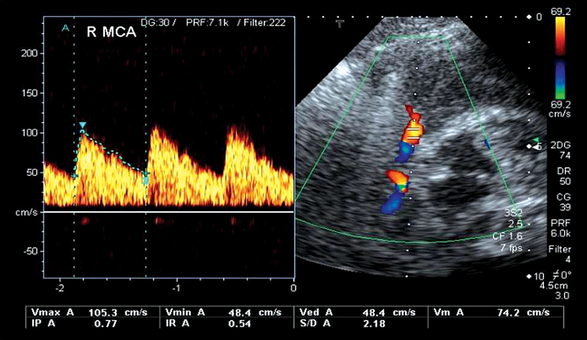
Doppler measurements
Basic cerebrovascular hemodynamics
![]()
Stay updated, free articles. Join our Telegram channel

Full access? Get Clinical Tree


Radiology Key
Fastest Radiology Insight Engine

